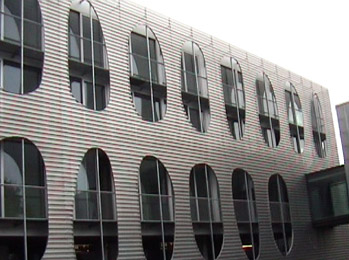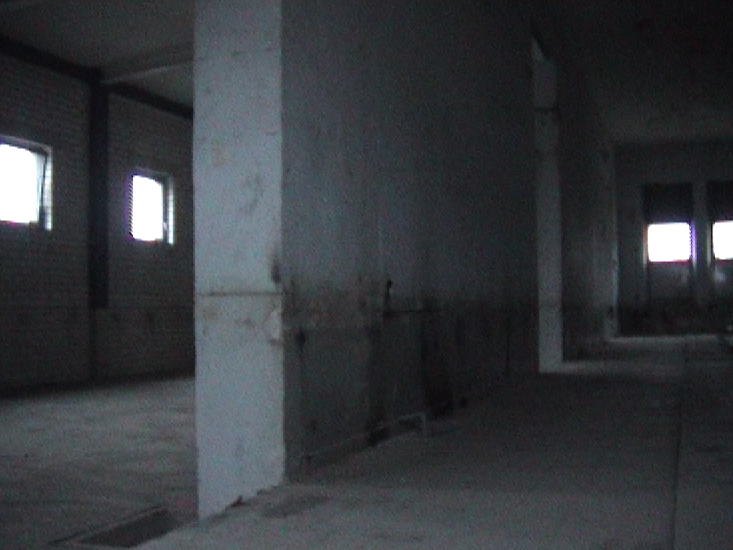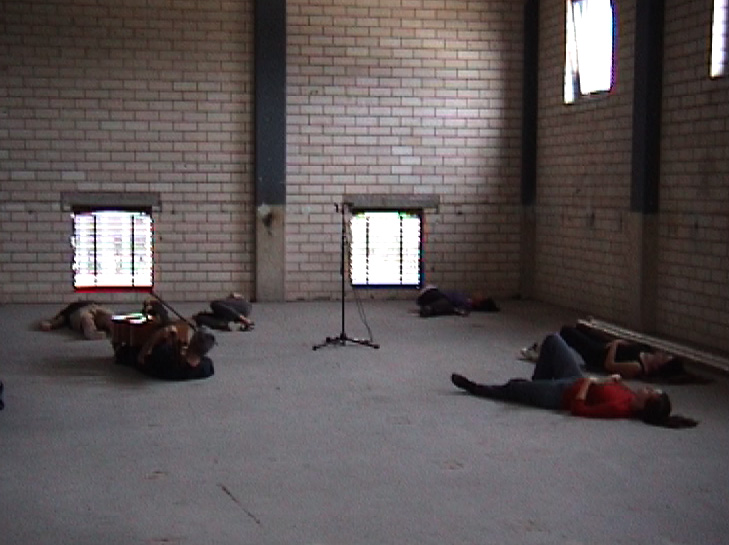
Johannes Birringer
The following notes take up my reflections on UKIYO and audiophonics (published on this website) and carry them into the actual process our lab team engaged in the first week of Interaktionslabor 2009. The examination of sound and sound perception, one of the main areas of reseaerch in the workshop, is here pursued through the compositional process and through the discussions the team has had on autism and psychoacoustics, visibility and invisibility, and to some extent the spectrum of tactile and olfactory perception in particular (narrative) spatial architecures.
Introduction: Re-sounding
In his account of his current research as an artist in residence at the Brain Mind Institute of EPFL, Lausanne, Switzerland, Luca Forcucci briefly looked back at the history of sound art and acousmatic music to contextualize his practices. The examples of his music which he had played ranged from a technorave concert (with laptop, electric cello and clarinette) to an audiovisual installation (The Cube) at SARC in 2007 where he premiered an interactive piece called "City Lights."
More recently, in 2008, he traveled to the Mamori Art Lab, directed by Francisco Lopez in Amazons, for field recording exploration and deep listening, and returned with a new composition from this journey which was presented here at the Lab. His residence in Lausannce is part of the programme Swiss Artists in La (supervised by Jill Scott). The research he conducts there is based on emotions, mental imagery and music generated by brain waves (EEG).
The historcial model Forcucci introduced was Alvin Lucier's Music for Solo Performer from 1965. From Forcucci's description, the archival film footage and the secondary literature, we learn that Lucier had early on composed chamber and orchestral works (since 1952), yet the composer and his critics count his 1965 composition Music for Solo Performer as the proper beginning of his compositional career. In this piece, EEG electrodes attached to the performer's scalp detect bursts of alpha waves generated when the performer achieves a meditative, non-visual brain state. These alpha waves are amplified and the resulting electrical signal is used to vibrate percussion instruments distributed around the performance space.
Other important earlier works include Vespers (1968), in which performers use hand-held echolocation devices to locate the approximate physical center of a room, to deepen their understanding of acoustical perception, and to reveal the elements of environmental space through non-visual means. One of Lucier's most important works is I am sitting in a room (1969), in which Lucier records himself narrating a text, and then plays the recording back into the room, re-recording it. The new recording is then played back and re-recorded, and this process is repeated. Since all rooms have a characteristic resonance (e.g., between a large hall and a small room), the effect is that certain frequencies are gradually emphasised as they resonate in the room, until eventually the words become unintelligible, replaced by the pure resonant harmonies and tones of the room itself. The recited text describes this process in action - it begins "I am sitting in a room, different from the one you are in now. I am recording the sound of my speaking voice...", and concludes with, "I regard this activity not so much as a demonstration of a physical fact, but more as a way to smooth out any irregularities my speech might have," referring to his own stuttering.
The psychological aspects (cross-modal perception and perturbances of channels and brain functions) will be addressed later, what is to be noted here are the artistic performance experiments we know from several disciplines, from (for example) Staina Vasulka's early work with violin and video loops or Nancy Holt's fascinating and impressive piece with vocal delays in her 1974 Boomerang (recorded on video by Richard Serra), to most recent choreographic collaborations between dancers and psychologist/neuroscientists, for example Wayne McGregor's AtaXia and the research project - Choregraphy and Cognition - led by Scott deLahunta; Otmas Gendera and Dieter Heitkamp's BrainDance project (2004), and the current Watching Dance: Kinesthetic Empathy - a multidisciplinary research collaboration involving four institutions (University of Manchester, University of Glasgow, York St John University and Imperial College London).
Forcucci then explained that he and Stefan Scheib used a similar process in the 10 KV ELECTRIC PLANT. To refer to the building more precisely, it is not a former electrical plant, but an Umschaltwerk (electrical transformer station) which is still in use and produces (as a side product) a constant low humming sound. Stefan and Luca had put together a string of concrete sound samples collected in the environment of the mine, from different loactions. These sounds were edited into a 7 minute sequence and then played back. 4 loudspeakers were positioned in the 10KV facing the walls, and the sounds were played/sounded and diffused into the architectural space, and this performance was recorded (first generation). The played sound is now recorded in the manner in which it sounded in the building. This first generation was then played back again, and recorded again, and this process of regeneration was repeated several times. (6 generations). Each time, the "soundscape" or the sounding is received in a new stage of reverberation/resonance with the concrete, material building. After several generations, the original sound object is increasingly blurred and changed, re-mirrored and distorted, and after 6 generations, the now existing sound is quite completely different from the original playback. Its living changes.
To hear the first and sixth generation of our sound work, which begins with the sentence (spoken by Katharina Bihler) "something is wrong with my ears"...please go to AUDIO.
2. Yes, I can hear my echo, and something is wrong with my ears
The architecture of the building has changed the sound. The perception of sound
in this case is then also a perception of space or of spatial realities or illusions
--perceptional structures -- spaces of hearing (sonic spatiality). An initial
discussion of sonic spatiality then needs to address architectures and shapes,
materials, size, volume, age and quality of buildings, as well as their resonating
capacities and existence, of course. A cathedral has a very different sonic
quality than a small carpeted bedroom. The industrial (concrete, steel, aluminum)
guest house in which our lab participants sleep and eat is quite badly constructed,
for example, in sonic terms, it is a beautiful building, with luscious rooms/suites,
but it is loud and insensensitive to acoustic concerns.

Its resonancivity is forbidding, in fact, as the concrete and steel design makes it hard and almost metallic in character, cold and stern, clean and modern-industrial. To some extent, it has a Bauhaus simplicity, absolute functionality and hyperelegance, but it is not built for humans needing to rest or find peace of concentration or relaxation within an already busy, changing, and transformative mine environment which often resembles a construction site.
The building has a high, sometimes piercingly hard echo, a clacking reverberation, each door falls hard into the lock, in fact the lcoks are also hard to open with the futuristic keys that need several second to decide (intelligent as they are) whether they are programmed to allow you, and just you, to open this door. Whereas our performance space, the 10KV transducer plant, has a wider, softer and deeper resonancivity that tends to be lower hertz and soothing but also immersive and extenuating. It allows space away from you, and sound to flow awa, rather than attack you. At the same time, I wonder how the texture and cleanliness of buildings contribiutes to the resonating factors. For example, the new Guesthouse has a kitchen and socal area which is high tech modern with concrete laminated floor, elegant steel and wood furnishings, aluminum and plexiglass as well as glass windows and large glass doors, metallic wings and silver/metallic kitchen utensils. It is very clean and hard-edged, whereas the 10KV building, which is probably a hundred years old, is dusty and heavy, slow and weary, worn, so to speak, its walls peeling and its door cracked, its brick walls and poured concrete are not even, there are alcoves and small protusions, as well as - most interestingly - holes in the floor which create openings to the level below, the cellarage.
The team has decided to make a performance text in the next few days, placing all of our speakers for sound diffusion into the lower level. We want to create a resonotor space that rise from the belly of the architecture. Down in the belly, there also is what Ludmila Pimentel refers to as the "herat" of the building, the transformer stations with its electromagnetic high eneregy fields.
 .
.
 .
.
10kV Transformer Building, with lab participants on the floor (far right)
On the est side upstairs, in the Hall that you see on the photos there are also a few hidden (almost inaccessible) rooms. and one of these rooms is the "mirror room", and another one is slowly and carefully prepared, by Ludmila, as Sybille's room. It has a scent, and it is lit in dark blue colors,. and it is only accessible via a ledge, that prevents a normal walk in. On the opposite east end, we rehearsed on Thursday night, in a long improvisation that made us make contact with the cold floor, the dust, the hardness which at the same time is a welcome openness, the space is able to house you. It lights you, it lets you breathe, and it echoes.
to be continued....
reference and links, provided by F. Scott Taylor
Postscript on resonation
Working on the draft of my proposed Keynote Addressh for an International conference on Contemporary Art and Spirituality in China next year, a good part of my research was taken up with finding ways to explain Kandinsky's notion in The Spiritual in Art that we respond to art with an "inner resonation" which arises as part of an "inner necessity" towards the spiritual, and that it is this that defines the principle of art. As a result I started looking at Hans Jenny's Science of Resonation, Cymatics, and followed the links. Now most of this will not be used and I thought it would be something of a waste of time not to share the time and effort with you.
CYMATICS
Branes = Membranes = Tissues = Vibration Plates, Fields, Fabrics et cetera =
Dimensions
Sound
Waves:
The
Art of Sound:
The
Art of Sound II: Resonance:
The
Colour of Sound:
Bringing Matter to Life
with Sound:
Bringing Matter to Life with Sound 2
Bringing
Matter to Life with Sound 3
OM:
Cymatics,
Language & DNA:
Cymatics,
Language & DNA:3
Cymatics,
Metatron’s Cube, Love & Gratitude: (annoying music video):
The
Pattern of All Patterns: Metatron’s Cube:
The
Pattern of All Patterns: Metatron’s Cube:2
The
Language of the Universe: (outstanding):
Rupert
Sheldrake – The Extended Mind – The Sense of Being Stared at:
Rupert Sheldrake – The Extended Mind – The Sense of Being Stared at 2
Rupert
Sheldrake – The Extended Mind – The Sense of Being Stared at 3
Chakra
Sound Healing:
The
Sound of Healing:
Brainwave
Vibration:
String
Theory and M Theory for Dummies:
String
Theory Model:
M
Theory Model:
Thunder Drums:
Singing
Drum Spinner:
900,000 volt van de Graaff Generator:
MerKaBa Activation of the Lightbody Elecromagnetic:
Merkaba,
The Chariot of Ascension:
Sound Art Exibit --
Frequency Test – Subtopics 20:
Singing
Electric Arc:
Plasma
Speaker / Singing Arc: Early Prototype:
___
Texte und Kommentare zum Labor 2009 werden hier veröffentlicht
Texts and commentaries on the 2009 lab and related research subjects will be published here.